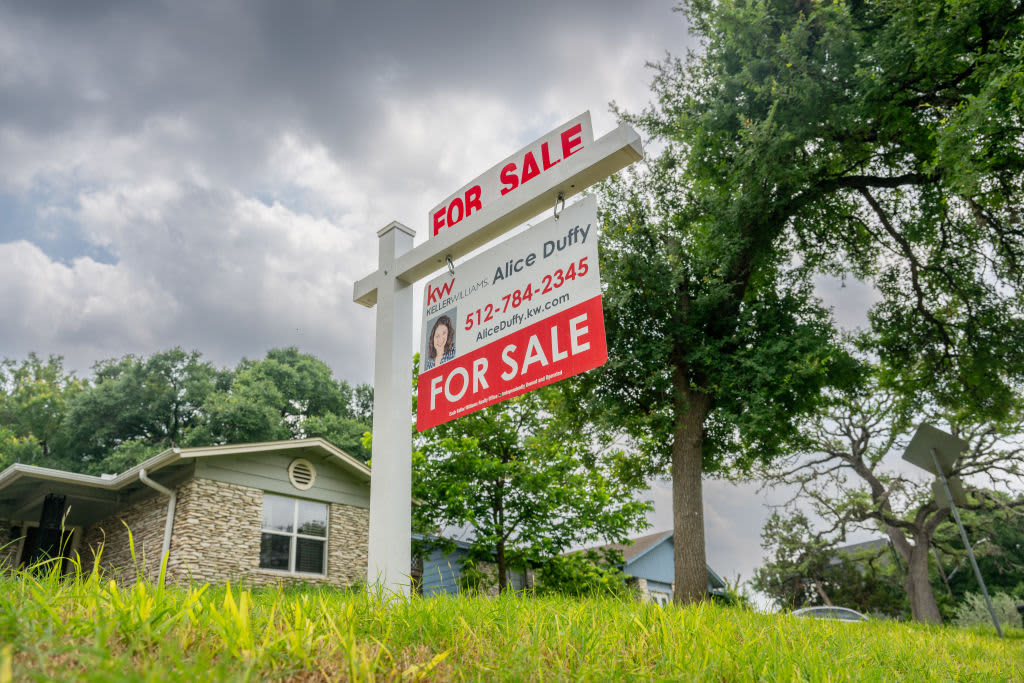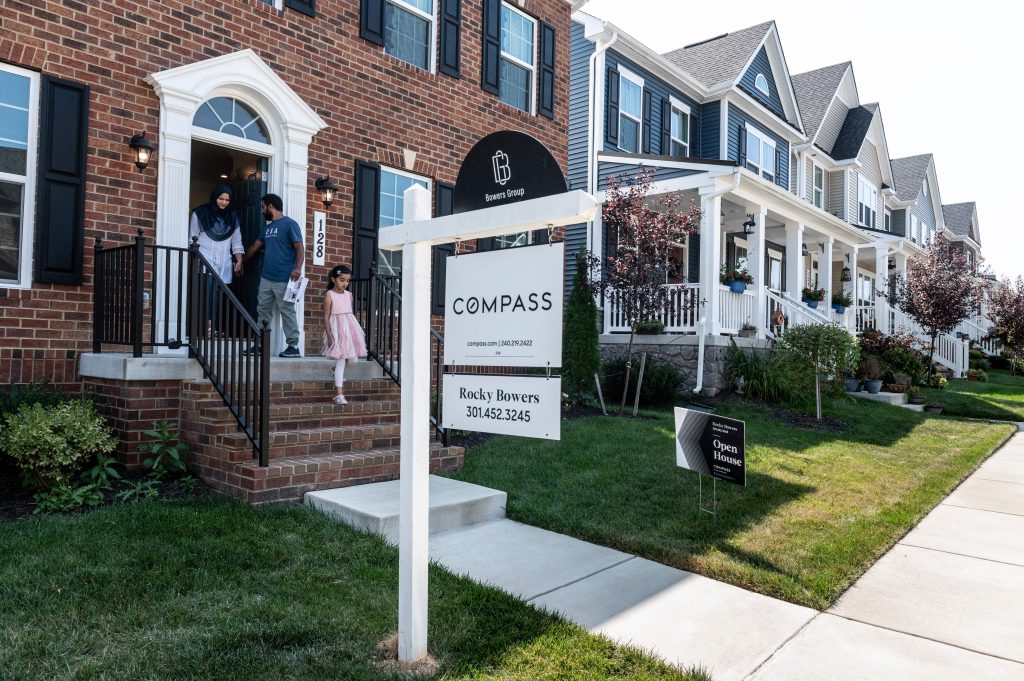
A home available for sale is shown on May 22, 2024 in Austin, Texas.
Brandon Bell | Getty Images
When Rachel Burress moved into her mother’s house around a decade ago, it seemed like a short-term stop on the path to homeownership.
The 35-year-old hairdresser spent those years improving her credit score and saving for a down payment. But with mortgage rates hovering near 7% and home prices skyrocketing, it doesn’t feel like the mother of three will be signing on the dotted line for a place of her own anytime soon.
“I don’t even know if I’ll ever get out and own my own home,” said Burress, who lives about 20 miles outside of Fort Worth, Texas, in a town called Aledo. “It feels like we are just stuck, and it is so hard to handle.”
Burress’ experience is reflective of the millions of Americans who’ve seen their financial and personal lives hindered by elevated price tags and high borrowing costs for homes. This can help to explain the sour sentiment about the state of the national economy.
It also sheds light on an existential anxiety for many: The American dream seems to be even more out of reach these days.
A double whammy
For aspiring homebuyers such as Burress, the combination of high mortgage rates and rising list prices has left them feeling boxed out.
The 30-year mortgage rate, a popular option for home financing in the U.S., has bounced around 7% for the past several months. It pulled back after hitting 8% for the first time since 2000 late last year. But that’s still a big jump from the sub-3% levels seen in the early years of the pandemic — which prompted a flurry of sales and refinancing in the housing market.
On the other side of the equation, rising sticker prices are also adding pressure. The Case-Shiller national home price index has hit all-time highs this year. Zillow’s home value index topped $360,000 in May, a nearly 50% increase from the same month five years ago.
In turn, affordability is down sharply compared with a few years ago. An April reading on the economic feasibility of homeownership from the Atlanta Federal Reserve was more than 36% off the pandemic high registered in the summer of 2020.
Nationally, the share of income needed to own the median-priced home last came in above 43%, per the Atlanta Fed. Any percentage over 30% is considered unaffordable.
The Atlanta Fed also found that the negative effects of high rates and prices more than outweighed the benefits from growing incomes for the typical American. That underscores the strength of these detractors, given that the average hourly wage on a private payroll has climbed more than 25% between June of 2019 and 2024.
‘A tough spot’
This tough environment has chilled activity for potential buyers and sellers alike.
Theoretically, current homeowners should be excited to see their property values rising quickly. But the prospective sellers are deterred by concerns about what rate they’d get on their next home, creating what a team at the Federal Housing Finance Agency called the “lock-in effect.”
There’s already evidence of this stalling in the market: Rates at these levels resulted in more than 875,000 fewer home sales in 2023, according to the team behind a FHFA working paper released earlier this year. That’s a sizable chunk, as the National Association of Realtors reported around 4 million existing houses were sold in the year.
On top of that, the FHFA found that a homeowner is 18.1% less likely to sell for every 1 percentage point their mortgage rate is under the current level. The typical borrower had a mortgage rate that was more than 3 percentage points below what they would have gotten in the final quarter of 2023.
If a homeowner had instead bought at the end of last year, the FHFA team found that their monthly principal and interest payments would cost around $500 more.
Given this, co-author Jonah Coste said current owners touting these low mortgage rates are undoubtedly better off than those looking to buy a first home today. But he said there’s a big catch for this cohort: Moving for a job opportunity or to accommodate a growing family becomes much more complicated.
“They’re not able to optimize their housing for their new life situation,” Coste said of this group. “Or, in some extreme circumstances, they’re not doing the big life changes that would necessitate having to move.”
That’s the predicament Luke Nunley finds himself in. In late 2020, the 33-year-old health administrator bought a three-bed, two-bath house with his wife in Kentucky at an interest rate under 3%. This home has more than doubled in value in almost four years.
After welcoming three kids, they’re holding off on a fourth until mortgage rates or home prices come down enough to upsize. Nunley knows the days of getting a rate below 3% are long gone, but can’t justify anything above 5.5%.
“It’s just a tough spot to be in,” Nunley said. “We’d be losing so much money at current rates that it’s basically impossible for us to move.”
Most Americans skirt 7%
Nunley is part of the overwhelming majority of Americans not paying these lofty mortgages.
The FHFA found that nearly 98% of mortgages were fixed at a level below the average rate of around 7.2% in the final quarter of last year. Like Nunley’s, close to 69% had rates more than 3 percentage points lower.
The buying boom early in the pandemic is one answer for why so many people aren’t paying the going rate. This eye-popping figure can also be explained by the rush to refinance during that period of low borrowing costs in 2020 and 2021.
While these low mortgage rates can help to fatten the pocketbooks of those holding them, Jeffrey Roach, LPL Financial’s chief economist, warned that it can be bad news for monetary policymakers. That’s because it doesn’t offer signs of interest rate hikes from the Federal Reserve successfully cooling the economy.
To be clear, mortgage rates tend to follow the path of Fed-set interest levels, but they aren’t the same thing. Still, Roach said that so many people being locked into low borrowing rates on their homes helps explain why tighter monetary policy hasn’t felt as restrictive as it has historically.
“Our economy is a lot less interest-rate sensitive,” Roach said. “That means the high rates aren’t really doing what it should be doing. It’s not putting the brakes on, like you would normally expect.”
Low housing supply has kept prices up, even as elevated borrowing fees bite into purchasing power. That flies in the face of conventional wisdom, which suggests that prices should slide as rates rise.
Looking longer term, experts said an increase in the volume of new housing can help expand access and cool high prices. In particular, Daryl Fairweather, chief economist at housing market database Redfin, said the national market could benefit from more townhomes and condos that are usually less expensive than typical homes.
Townhouse for sale sign, Corcoran Realty, in driveway of row houses, Forest Hills, Queens, New York.
Lindsey Nicholson | UCG | Universal Images Group | Getty Images
‘The ultimate goal’
For now, this new reality has created generational differences in homeownership and what the road to it looks like.
Zillow found that 34% of all mortgage holders received a financial gift or loan from family or friends for a down payment in 2019. In 2023, that number jumped to 43% as affordability plummeted.
It’s also much harder for young people to get on track for purchasing a home than it was for their parents, Zillow data shows. Today, it takes almost nine years to save 20% for a down payment using 10% of the median household income every month. In 2000, it required less than six years.
“It’s not the avocado toast,” said Skylar Olsen, Zillow’s chief economist, referencing a joke that millennials spend too much on luxuries like brunch or coffee.
Olsen said younger generations should adjust their expectations around ownership given the tougher environment. She said these Americans should expect to rent for longer into adulthood, or plan to attain their first home in part through extra income from renting out a room.
For everyday people like Burress, the housing market remains top of mind, as the Texan considers her financial standing and evaluates candidates in the November election. The hairdresser has continued helping her mom with payments on home insurance, utility bills and taxes in lieu of a formal rent.
Burress is still hoping to one day put that money toward an equity-building property of her own. But time and time again, unexpected expenses like a totaled car or macroeconomic variables such as rising mortgage rates have left her feeling like the dream is out of reach.
“It is the ultimate goal for me and my family to get out of my mom’s house,” she said. But, “it feels like I’m on a hamster wheel.”

